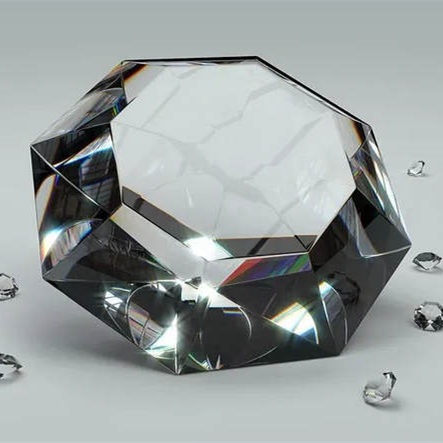
Diamonds are one of the most expensive items on the planet in terms of unit price, currently a single la diamond can be sold for tens of thousands of dollars, and if the diamond is relatively large, Even a carat can fetch hundreds of thousands or millions.
The reason why diamonds are so expensive is that they are rare and valuable. Because diamonds themselves are so rare, the number of naturally mineable diamonds on the planet is small and the market supply is high.
The small number of naturally minable stones on the planet and the very low supply on the market have resulted in diamonds being very expensive.

However, even though they are expensive, they do not stop people from going after them.The diamond ring seems to have become a symbol of love and an eternal token of love.When an object is given a 'spiritual value', even if it is just an ordinary stone, it can fetch a high price.But where there is money to be made, there is a market, and with the high price of diamonds, many people have been thinking of ways to create more of them.
In addition to mining natural diamonds from nature, others have used technology to develop lab grown diamonds. The search for lab diamonds began in the 19th century, but technical limitations have prevented the creation of lab diamonds.
But in the 20th century, with the advent of the hotter, more expensive diamonds, it was not possible to produce them. In the 20th century, however, thermodynamics and high-temperature and high-pressure technology became more sophisticated, providing the technical basis for synthetic diamonds.

By 1970, General Electric announced the synthesis of carat-quality gemstones; in 1987, De Beers of South Africa synthesised 11 carat-quality diamonds. In 1987, De Beers of South Africa synthesised an 11.14 ct gem-quality diamond, and in 1990 it succeeded in synthesising a single crystal of very good quality, weighing 14.2ct.
However, these early artificial diamonds were relatively small, with small grains that were not comparable to natural diamonds, and so were initially disliked.

At first they were disliked and were only used for industrial cutting.
However, in recent years, with the advances in artificial diamond manufacturing technology, man has now been able to synthesise gem-quality, pure, colourful
These diamonds are so different from natural diamonds that they cannot be seen with the naked eye and can only be identified with the help of professional identification instruments and by professional
It is only with the help of specialist identification equipment and professional institutes that we can identify the difference between a synthetic diamond and a natural diamond. And the GIA Gemological Institute of America.
This means that synthetic diamonds can be almost as genuine as fake ones. The opportunity to make a fortune.As the technology for synthetic diamonds continues to mature, many Chinese businesses are entering the field and China is now the China is now the world's largest manufacturer of artificial diamonds.
It is said that China's artificial diamond production has reached over 10 billion carats, accounting for over 90% of the world's artificial diamond production capacity. It stands to reason that the price of any product could fall rapidly if the Chinese were to master the technology, and this has proved to be the case.
This has proved to be the case.It is inferred that China's artificial diamond production capacity is so large that it could gain significant pricing power in the diamond market, and could even have a major impact on natural After all, there is little difference between synthetic diamonds and natural diamonds at the moment, and the average businessman can't even see the difference.

Even if synthetic diamonds were installed in diamond rings, consumers would not be able to identify them. But the reality is that even though China has a huge production capacity for synthetic diamonds, the impact on the natural diamond market is still minimal and natural diamonds are still very expensive.
The price of natural diamonds is still very high. So why is it that China has so much artificial diamond production capacity, yet it has no impact on global diamond prices?
The fact is that there is no significant difference between natural diamonds and synthetic diamonds. To use an analogy, a natural diamond is like a wild puffer fish, while an artificial diamond is the equivalent of a farmed puffer fish.
However, because the production environment is different, there is a huge difference in price between the two, and as a result, most of the synthetic diamonds produced in China are currently used in the industrial sector.
The result is that most synthetic diamonds produced in China are currently used in the industrial sector, with very few actually entering the jewellery market, and even when they do, not many of them are recognised by the market.
As a result, most synthetic diamonds produced in China are currently used in the industrial sector, with very few actually entering the jewellery market.
However, in the future, as people's perception of diamonds continues to change, I believe the share of synthetic diamonds in the jewellery market will grow, and people's reliance on natural diamonds will increase.
This can be seen in the definition of a diamond in the United States.
The US Federal Trade Commission (FTC) has removed the word 'natural' from the basic definition of a diamond in its 2018 jewellery guidelines and no longer recommends the use of the term 'natural'. and no longer recommends the term 'synthetic' for laboratory-produced diamonds, meaning that synthetic diamonds have been given an unprecedented status.
This means that the status of synthetic diamonds has been elevated to an unprecedented level. This is actually a good start for the diamond industry, and a good pavement for the entry of synthetic diamonds into the jewellery market, as long as people can change their perception of diamonds.
As long as people can change their perception of diamonds, synthetic diamonds will have a great future. But even if the share of synthetic diamonds in the jewellery market increases further, they will not be able to replace natural diamonds completely.
The price of natural diamonds will remain high and out of reach of synthetic diamonds. When an object is labelled as 'man-made', even if its quality is no different from that of a natural object, its value is still not comparable to that of a natural object.
The fact is that the value of a diamond is more of a In fact, the value of a diamond is more of a spiritual attachment than a value in itself, and when a diamond is imbued with the light of love, it becomes more valuable.
When a diamond is given the sparkle of love, its value rises.
When a diamond is imbued with the sparkle of love, its value soars. In terms of value, a natural diamond is clearly more desirable than the 'artifice' of a cultivated diamond. Once this sentimental value has been exploited by some businesses, they can artificially control the supply of diamonds in order to raise prices.
This is the case with diamonds. In reality, the earth's diamond reserves are not low, but most of them are buried deep in the earth and not many diamonds have been discovered by man. The majority of diamonds are buried at great depths and not many have been identified.
At present, there are approximately 2.5 billion carats of diamonds in proven reserves, but these proven reserves are relatively concentrated, mainly in a few countries such as Australia and South Africa.
These two countries are also currently the world's leading suppliers of diamonds, but they do not carry out many diamond projects each year. These two countries are also currently the world's leading suppliers of diamonds, but the number of diamonds they produce each year is not very large, only tens of millions of carats, which in effect artificially controls the supply of the market.
And of the limited supply of diamonds, most are controlled by a few diamond companies, such as De Beers in South Africa. When the supply is controlled by a small number of companies, prices seem to depend on the mood of these people.














